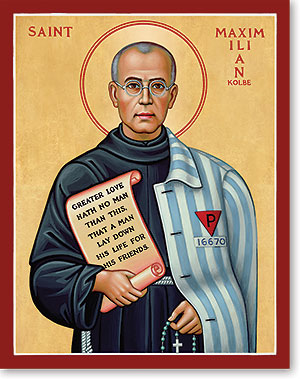 One of the few advantages that modern times has given religion is a new immediacy of the lives of the saints of our times. Through their writings, the accounts of those who knew them, and even photographs, we come to a deeper and more vivid appreciation of the greatness of their sanctity and their journey to this greatness.
One of the few advantages that modern times has given religion is a new immediacy of the lives of the saints of our times. Through their writings, the accounts of those who knew them, and even photographs, we come to a deeper and more vivid appreciation of the greatness of their sanctity and their journey to this greatness.
Such is the case with Saint Maximilian Kolbe, commemorated on August 14th, reknowned for his self-sacrifice in Auchswitz. Born in 1894 in Poland, the path of his life was great influenced by a childhood vision of the Virgin Mary that was preceded by his mother's remonstrance for his childish behavior: "Raymond, what will become of you?" Retiring to the chapel in the family house, he prayed in tears for heavenly help:
 "That night I asked the Mother of God what was to become of me, a Child of Faith. Then she came to me holding two crowns, one white, the other red. She asked me if I was willing to accept either of these crowns. The white one meant that I should persevere in purity, and the red that I should become a martyr. I said that I would accept them both."
"That night I asked the Mother of God what was to become of me, a Child of Faith. Then she came to me holding two crowns, one white, the other red. She asked me if I was willing to accept either of these crowns. The white one meant that I should persevere in purity, and the red that I should become a martyr. I said that I would accept them both."
A monk, a priest, and a "general"
In 1907 the young saint and his brother stole across the Austria-Hungary border to join the Franciscan Order. Later as a student in Rome, in response to shameful public attacks on the Church, he organized the Militia Immaculata, or the Army of Mary, to work for the conversion of disbelievers and enemies of the Church.
 His "army" utilized the benefits of modern printing and technology, with a monthly magazine with a circulation of over one million. St. Maximilian used the radio to spread the Catholic faith and to speak out against the Nazi regime. He is the only canonized saint to have held an amateur radio license.
His "army" utilized the benefits of modern printing and technology, with a monthly magazine with a circulation of over one million. St. Maximilian used the radio to spread the Catholic faith and to speak out against the Nazi regime. He is the only canonized saint to have held an amateur radio license.
After his priestly ordination he returned to the newly independent Poland, a liberation he attributed to the Holy Virgin. Despite an advanced case of tuberculosis he entered into a whirlwind of activity, promoting devotion to the Virgin Mary, and founding and supervising a monastery named Niepokalanow, "the City of the Immaculate," which became one of the largest friaries in the world. He also began a seminary and a radio station. The journalistic and radio works of the monastery had a nationwide effect, rallying all under the banner of Mary. Years later, after the war, the Polish bishops sent an official letter to the Holy See claiming that Fr. Kolbe's magazine had prepared the Polish nation to endure and survive the horrors of the war that was soon to follow.
Mary's Apostle in Japan
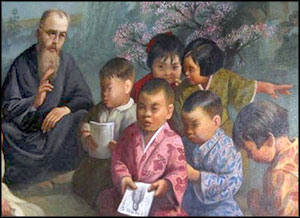 In 1930, with little money and no knowledge of Japanese, St. Maximilian and four brothers travelled to Nagasaki, Japan, where they began their missionary work in a poor hut with nothing but straw for their beds. Within a month they had a printing press and were distributing their newsletter, and within a year a new monastery was established.
In 1930, with little money and no knowledge of Japanese, St. Maximilian and four brothers travelled to Nagasaki, Japan, where they began their missionary work in a poor hut with nothing but straw for their beds. Within a month they had a printing press and were distributing their newsletter, and within a year a new monastery was established.
In the face of evil
Returning to his homeland, during World War II St. Maximilian provided shelter to many refugees from Poland, including 2,000 Jews he hid from the Nazis in his friary. In February 1941 he was arrested and imprisoned by the German Gestapo. A witness tells us that in March of that year an SS guard, seeing this man in his habit girdled with a rosary, asked if he believed in Christ. When the priest calmly replied, "I do," the guard struck him. The SS man repeated his question several times and receiving always the same answer went on beating him mercilessly. Shortly afterwards the Franciscan habit was taken away and a prisoner's garment was substituted.
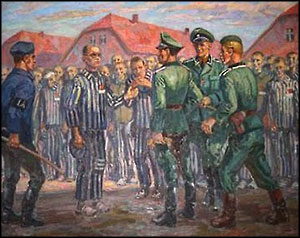 Fr. Maximilian was soon deported with 300 other prisoners to Auschwitz, where he received his striped convict's garments and was branded with the number 16670. He was put to work immediately carrying blocks of stone for the construction of a crematorium wall. Sometimes his colleagues would try to come to his aid but he would not expose them to danger. Always he replied, "Mary gives me strength. All will be well." At this time he wrote to his mother, "Do not worry about me or my health, for the good Lord is everywhere and holds every one of us in his great love."
Fr. Maximilian was soon deported with 300 other prisoners to Auschwitz, where he received his striped convict's garments and was branded with the number 16670. He was put to work immediately carrying blocks of stone for the construction of a crematorium wall. Sometimes his colleagues would try to come to his aid but he would not expose them to danger. Always he replied, "Mary gives me strength. All will be well." At this time he wrote to his mother, "Do not worry about me or my health, for the good Lord is everywhere and holds every one of us in his great love."
A light in darkness
In Auschwitz, where hunger and hatred reigned and faith evaporated, this man opened his heart to others and spoke of God's infinite love. When food was brought in and everyone struggled to get his place in the queue so as to be sure of a share, Fr. Maximilian stood aside, so that frequently there was none left for him. At other times he shared his meagre ration of soup or bread with others.
Men gathered in secret to hear his words of love and encouragement, but it was his example which counted for most. Fr. Zygmunt Rusczak remembers: "Each time I saw Father Kolbe in the courtyard I felt within myself an extraordinary effusion of his goodness. Although he wore the same ragged clothes as the rest of us, with the same tin can hanging from his belt, one forgot his wretched exterior and was conscious only of the charm of his inspired countenance and of his radiant holiness."
Greater love than this hath no man
In July 1941 three prisoners disappeared from the camp, prompting the camp commander to pick ten men to be starved to death in an underground bunker in order to deter further escape attempts. When one of the selected men cried out, "My wife! My children!", the holy priest volunteered to take his place.
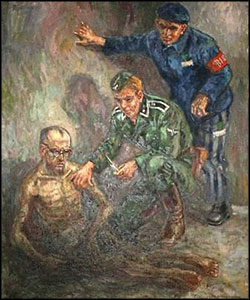 In the starvation cell Saint Maximilian celebrated Mass each day and led the prisoners in the recitation of the Rosary and singing of hymns. An eyewitness later wrote: "At every inspection, when almost all the others were now lying on the floor, Father Kolbe was seen kneeling or standing in the centre as he looked cheerfully in the face of the SS men. Two weeks passed in this way. Meanwhile one after another they died, until only Father Kolbe was left. This the authorities felt was too long; the cell was needed for new victims. So one day they brought in the head of the sickquarters, a German, a common criminal named Bock, who gave Father Kolbe an injection of carbolic acid in the vein of his left arm. Fr Kolbe, with a prayer on his lips, himself gave his arm to the executioner. Unable to watch this I left under the pretext of work to be done. Immediately after the SS men with the executioner had left I returned to the cell, where I found Father Kolbe leaning in a sitting position against the back wall with his eyes open and his head dropping sideways. His face was calm and radiant." His remains were cremated on 15 August, the feast of the Assumption of Mary.
In the starvation cell Saint Maximilian celebrated Mass each day and led the prisoners in the recitation of the Rosary and singing of hymns. An eyewitness later wrote: "At every inspection, when almost all the others were now lying on the floor, Father Kolbe was seen kneeling or standing in the centre as he looked cheerfully in the face of the SS men. Two weeks passed in this way. Meanwhile one after another they died, until only Father Kolbe was left. This the authorities felt was too long; the cell was needed for new victims. So one day they brought in the head of the sickquarters, a German, a common criminal named Bock, who gave Father Kolbe an injection of carbolic acid in the vein of his left arm. Fr Kolbe, with a prayer on his lips, himself gave his arm to the executioner. Unable to watch this I left under the pretext of work to be done. Immediately after the SS men with the executioner had left I returned to the cell, where I found Father Kolbe leaning in a sitting position against the back wall with his eyes open and his head dropping sideways. His face was calm and radiant." His remains were cremated on 15 August, the feast of the Assumption of Mary.
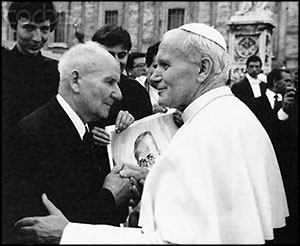
At the canonization of Saint Maximilian Kolbe in 1982, Pope John Paul II embraces Franciszek Gajowniczek, the man whose place St. Maximilian took in the death cell at Auschwitz.
"The patron saint of our difficult century"
Saint Maximilian was canonized on October 10, 1982 by his compatriot, Pope John Paul II, who declared him a martyr of charity. He is the patron saint of drug addicts, political prisoners, families, journalists, prisoners, and the pro-life movement. Pope John Paul II declared him "the patron saint of our difficult century." Saint Maximilian's canonization was attended by Franciszek Gajowniczek, by this time in his 90's – the man whose place Saint Maximilian took in the death cell at Auschwitz.